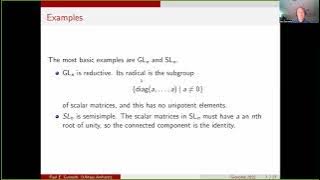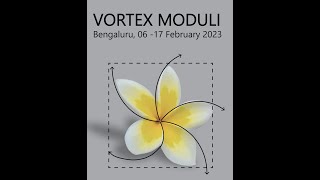
Paul GUNNELLS - Cohomology of arithmetic groups and number theory: geometric, ... 2
In this lecture series, the first part will be dedicated to cohomology of arithmetic groups of lower ranks (e.g., Bianchi groups), their associated geometric models (mainly from hyperbolic geometry) and connexion to number theory. The second part will deal with higher rank groups, mainly
From playlist École d'Été 2022 - Cohomology Geometry and Explicit Number Theory

Aurel PAGE - Cohomology of arithmetic groups and number theory: geometric, ... 2
In this lecture series, the first part will be dedicated to cohomology of arithmetic groups of lower ranks (e.g., Bianchi groups), their associated geometric models (mainly from hyperbolic geometry) and connexion to number theory. The second part will deal with higher rank groups, mainly
From playlist École d'Été 2022 - Cohomology Geometry and Explicit Number Theory

The idea of a quotient group follows easily from cosets and Lagrange's theorem. In this video, we start with a normal subgroup and develop the idea of a quotient group, by viewing each coset (together with the normal subgroup) as individual mathematical objects in a set. This set, under
From playlist Abstract algebra

Paul GUNNELLS - Cohomology of arithmetic groups and number theory: geometric, ... 1
In this lecture series, the first part will be dedicated to cohomology of arithmetic groups of lower ranks (e.g., Bianchi groups), their associated geometric models (mainly from hyperbolic geometry) and connexion to number theory. The second part will deal with higher rank groups, mainly
From playlist École d'Été 2022 - Cohomology Geometry and Explicit Number Theory

This video contains the origins of group theory, the formal definition, and theoretical and real-world examples for those beginning in group theory or wanting a refresher :)
From playlist Summer of Math Exposition Youtube Videos

Definition of a group Lesson 24
In this video we take our first look at the definition of a group. It is basically a set of elements and the operation defined on them. If this set of elements and the operation defined on them obey the properties of closure and associativity, and if one of the elements is the identity el
From playlist Abstract algebra

Aurel PAGE - Cohomology of arithmetic groups and number theory: geometric, ... 1
In this lecture series, the first part will be dedicated to cohomology of arithmetic groups of lower ranks (e.g., Bianchi groups), their associated geometric models (mainly from hyperbolic geometry) and connexion to number theory. The second part will deal with higher rank groups, mainly
From playlist École d'Été 2022 - Cohomology Geometry and Explicit Number Theory

Group theory 2: Cayley's theorem
This is lecture 2 of an online mathematics course on group theory. It describes Cayley's theorem that every abstract group is the group of symmetries of something, and as examples shows the Cayley graphs of the Klein 4-group and the symmetric group on 3 points.
From playlist Group theory

The Completed Cohomology of Arithmetic Groups - Frank Calegari
Frank Calegari Northwestern University; Member, School of Mathematics October 13, 2010 The cohomology of arithmetic groups (with real coefficients) is usually understood in terms of automorphic forms. Such methods, however, fail (at least naively) to capture information about torsion clas
From playlist Mathematics

Cohomological Field Theories from GLSMs (Lecture 2) by David Favero
PROGRAM: VORTEX MODULI ORGANIZERS: Nuno Romão (University of Augsburg, Germany) and Sushmita Venugopalan (IMSc, India) DATE & TIME: 06 February 2023 to 17 February 2023 VENUE: Ramanujan Lecture Hall, ICTS Bengaluru For a long time, the vortex equations and their associated self-dual fie
From playlist Vortex Moduli - 2023

Cup Products in Automorphic Cohomology - Matthew Kerr
Matthew Kerr Washington University in St. Louis March 30, 2012 In three very interesting and suggestive papers, H. Carayol introduced new aspects of complex geometry and Hodge theory into the study of non-classical automorphic representations -- in particular, those involving the totally d
From playlist Mathematics

Motivic action on coherent cohomology of Hilbert modular varieties - Aleksander Horawa
Joint IAS/Princeton University Number Theory Seminar Topic: Motivic action on coherent cohomology of Hilbert modular varieties Speaker: Aleksander Horawa Affiliation: University of Michigan Date: February 03, 2022 A surprising property of the cohomology of locally symmetric spaces is tha
From playlist Mathematics

Weil conjectures 6: etale cohomology of a curve
We give an overview of how to calculate the etale cohomology of a nonsinguar projective curve over an algebraically closed field with coefficients Z/nZ with n invertible. We simply assume a lot of properties of etale cohomology without proving (or even defining) them.
From playlist Algebraic geometry: extra topics

Vladimir Berkovich: de Rham theorem in non-Archimedean analytic geometry
Abstract: In my work in progress on complex analytic vanishing cycles for formal schemes, I have defined integral "etale" cohomology groups of a compact strictly analytic space over the field of Laurent power series with complex coefficients. These are finitely generated abelian groups pro
From playlist Algebraic and Complex Geometry

Galilean group cohomology in classical mechanics
In this video we discuss how the second group cohomology relates to classical mechanics. We discuss Galilean invariance in the Lagrangian formalism and its quantum mechanics analog. You find the used text and all the links mentioned here: https://gist.github.com/Nikolaj-K/deb54c9127b6f0f3f
From playlist Algebra

Cohomological decomposition of the diagonal in small dimension (Lecture - 05) by Claire Voisin
Infosys-ICTS Ramanujan Lectures Some new results on rationality Speaker: Claire Voisin (College de France) Date: 01 October 2018, 16:00 Venue: Madhava Lecture Hall, ICTS campus Resources Lecture 1: Some new results on rationality Date & Time: Monday, 1 October 2018, 04:00 PM Abstra
From playlist Infosys-ICTS Ramanujan Lectures

Jacek Brodzki (6/30/17) Bedlewo: The Geometry of Synchronization Problems and Learning Group Act
We develop a geometric framework that characterizes the synchronization problem — the problem of consistently registering or aligning a collection of objects. We formulate a theory that characterizes the cohomological nature of synchronization based on the classical theory of fibre bundles
From playlist Applied Topology in Będlewo 2017

Lars Hesselholt: Around topological Hochschild homology (Lecture 8)
The lecture was held within the framework of the (Junior) Hausdorff Trimester Program Topology: "Workshop: Hermitian K-theory and trace methods" Introduced by Bökstedt in the late eighties, topological Hochschild homology is a manifestation of the dual visions of Connes and Waldhausen to
From playlist HIM Lectures: Junior Trimester Program "Topology"

Cong Xue - 2/2 Cohomology Sheaves of Stacks of Shtukas
Cohomology sheaves and cohomology groups of stacks of shtukas are used in the Langlands program for function fields. We will explain (1) how the Eichler-Shimura relations imply the finiteness property of the cohomology groups, (2) how the finiteness and Drinfeld's lemma imply the action of
From playlist 2022 Summer School on the Langlands program

What is a Group? | Abstract Algebra
Welcome to group theory! In today's lesson we'll be going over the definition of a group. We'll see the four group axioms in action with some examples, and some non-examples as well which violate the axioms and are thus not groups. In a fundamental way, groups are structures built from s
From playlist Abstract Algebra